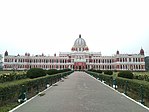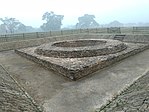Cooch Behar district
Cooch Behar district | |
|---|---|
|
Clockwise from top-left: Cooch Behar Palace, Gadadhar river near Tufanganj | |
| Area | |
| • Total | 3,387 km2 (1,308 sq mi) |
| Population (2011) | |
| • Total | 2,819,086 |
| • Density | 830/km2 (2,200/sq mi) |
| • Urban | 10.27% |
| Demographics | |
| • Literacy | 74.78% (2011) |
| • Sex ratio | 942 (2011) |
| Time zone | UTC+05:30 (IST) |
| Vehicle registration | WB-64 |
| Major highways | NH 17 |
| Average annual precipitation | 3201 mm |
| Website | coochbehar |
Cooch Behar district (pronounced [ˈkuːtʃ biˈɦaːr]) is a district of the Indian state of West Bengal.
Formerly part of the Kamarupa kingdom, the area became the heart of the Kamata Kingdom in the 12th century. During the British Raj, the district was known as Cooch Behar state ruled by the Koch dynasty until 1949, when it became part of India.
The district consists of the flat plains of
Etymology
The name Cooch Behar is derived from two words—Cooch, a corrupted form of the word Koch, the name of the
History
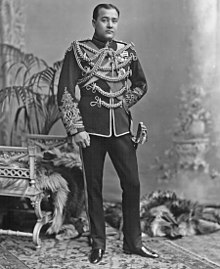
Early period
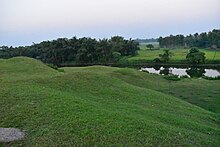
Cooch Behar formed part of the
The first important Koch ruler was Biswa Singha, who came to power in 1515.[4] Under his son, Nara Narayan, the Kamata Kingdom reached its zenith.[5] Nara Narayan's younger brother, Shukladhwaj (Chilarai), was a noted military general who undertook expeditions to expand the kingdom. He became governor of its eastern portion.
After Chilarai's death, his son Raghudev became governor of this portion. Since Nara Narayan did not have a son, Raghudev was seen as the heir apparent. However, a late child of Nara Narayan removed Raghudev's claim to the throne. To placate him, Nara Narayan had to anoint Raghudev as a vassal chief of the portion of the kingdom east of the
As the early capital of the Koch Kingdom, Cooch Behar's location was not static and became stable only when shifted to Cooch Behar town. Maharaja Rup Narayan, on the advice of an unknown saint, transferred the capital from Attharokotha to
In 1661 CE, Maharaja Pran Narayan planned to expand his kingdom. However,
British Raj
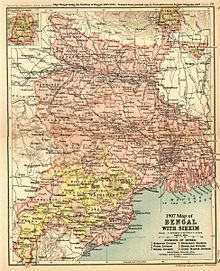
In 1772–1773, the king of
The
Post Independence
Under an agreement between the kings of Cooch Behar and the Indian Government at the end of British rule, Maharaja Jagaddipendra Narayan transferred full authority, jurisdiction and power of the state to the Dominion Government of India, effective 12 September 1949.[11] Eventually, Cooch Bihar became part of the state of West Bengal on 19 January 1950, with Cooch Behar town as its headquarters.[11]
A geopolitical curiosity was that there were 92 Bangladeshi
Twenty-one of the Bangladeshi exclaves were within Indian exclaves, and three of the Indian exclaves were within Bangladeshi exclaves. The largest Indian exclave was Balapara Khagrabari which surrounded a Bangladeshi exclave, Upanchowki Bhajni, which itself surrounded an Indian exclave called
Geography

Cooch Behar is a district under the
A geopolitical curiosity was that there were 92 Bangladeshi
Twenty-one of the Bangladeshi exclaves were within Indian exclaves, and three of the Indian exclaves were within Bangladeshi exclaves. The largest Indian exclave was Balapara Khagrabari which surrounded a Bangladeshi exclave, Upanchowki Bhajni, which itself surrounded an Indian exclave called
Rivers and topography
Cooch Behar is a flat region with a slight southeastern slope along which the main rivers of the district flow. Most of the highland areas are in the Sitalkuchi region and most of the low-lying lands lie in Dinhata region.
The rivers in the district of Cooch Behar generally flow from northwest to southeast. Seven rivers that cut through the district are the
Flora and fauna
In 1976 Cooch Behar district became home to the Jaldapara Wildlife Sanctuary (now Jaldapara National Park), which has an area of 217 km2 (83.8 sq mi).[13] It shares the park with Alipurduar district.[13]
Demographics
| Year | Pop. | ±% p.a. |
|---|---|---|
| 1901 | 565,116 | — |
| 1911 | 591,012 | +0.45% |
| 1921 | 590,599 | −0.01% |
| 1931 | 589,053 | −0.03% |
| 1941 | 638,703 | +0.81% |
| 1951 | 668,949 | +0.46% |
| 1961 | 1,019,806 | +4.31% |
| 1971 | 1,414,183 | +3.32% |
| 1981 | 1,771,643 | +2.28% |
| 1991 | 2,171,145 | +2.05% |
| 2001 | 2,479,155 | +1.34% |
| 2011 | 2,819,086 | +1.29% |
| source:[14] | ||
According to the
Religion
| Religion | Population (1941)[18]: 104–105 | Percentage (1941) | Population (2011)[17] | Percentage (2011) |
|---|---|---|---|---|
| Hinduism |
394,948 | 61.63% | 2,087,766 | 74.05% |
| Islam |
242,684 | 37.87% | 720,033 | 25.54% |
| Others[a] | 3,210 | 0.5% | 11,287 | 0.41% |
| Total Population | 640,842 | 100% | 2,819,086 | 100% |
Hinduism is the majority religion. Islam is the minority religion, and is mainly rural. Muslims are a significant minority in Dinhata I (36.98%), Dinhata II (36.68%) and Sitalkuchi (35.31%) blocks.[17]
Language
Languages of Cooch Behar district (2011)[19]
At the time of the 2011 census, 94.79% of the population spoke Bengali, 1.31% Rajbongshi and 1.17% Hindi as their first language. 2.01% of the population recorded their language as 'Others' under Bengali.[19]
Government and politics
Divisions
Sub-divisions
The district of Cooch Behar comprises five sub-divisions:
- Cooch Behar Sadar subdivision
- Dinhata subdivision
- Mathabhanga subdivision
- Tufanganj subdivision
- Mekhliganj subdivision
Assembly constituencies
As per order of the 2008
Politics
| No. | Constituency | Name | Party | Remarks | |
|---|---|---|---|---|---|
| 1 | Mekliganj | Paresh Chandra Adhikary | All India Trinamool Congress
|
||
| 2 | Mathabhanga | Sushil Barman | Bharatiya Janata Party | ||
| 3 | Cooch Behar Uttar
|
Sukumar Roy | Bharatiya Janata Party | ||
| 4 | Cooch Behar Dakshin
|
Nikhil Ranjan Dey | Bharatiya Janata Party | ||
| 5 | Sitalkuchi | Baren Chandra Barman | Bharatiya Janata Party | ||
| 6 | Sitai | Jagadish Chandra Barma Basunia | All India Trinamool Congress
|
||
| 7 | Dinhata | Nisith Pramanik | Bharatiya Janta Party
|
Resigned[21] | |
| Udayan Guha[BYE] | All India Trinamool Congress
|
Won in 2021 bypoll | |||
| 8 | Natabari | Mihir Goswami | Bharatiya Janata Party | Deputy Leader of Opposition | |
| 9 | Tufanganj | Malati Rava Roy | Bharatiya Janata Party | ||
Mekliganj, Mathabhanga, Cooch Behar Uttar, Sitalkuchi and Sitai constituencies are reserved for
Education
- Baramaricha Delwar Hossain (X+2) High School
- Suniti Academy
Towns and villages
See also
- Indo-Bangladesh enclaves
- List of enclaves and exclaves
- List of West Bengal districts ranked by literacy rate
References
- ^ a b "Census of India : Scheduled Castes & Scheduled Tribes Population". www.censusindia.gov.in. Retrieved 5 February 2021.
- ^ Pal, Dr. Nripendra Nath (2000). Itikathai Cooch Behar (A brief history of Cooch Behar). Kolkata: Anima Prakashani. pp. 11–12.
- ^ The name Cooch Behar is a compound of two words: Cooch and Behar. Cooch is a corrupted form of Coch or Koch, the name of an ethnic group of people inhabiting largely in vast tract of land to the north-east of Bengal. Behar or more properly Vihara denotes abode or sport. Cooch Behar means, therefore, the abode or land of the Koches. Ray, B.. CENSUS 1961 WEST BENGAL. GOVERNMENT PRINTING, WEST BENGAL, 1961, p.20
- ISBN 8170991099
- ^ "Royal History of Cooch Behar". Retrieved 22 October 2006.
- ^ Pal, Dr. Nripendra Nath (2000). Itikathai Cooch Behar (A brief history of Cooch Behar). Kolkata: Anima Prakashani. p. 68.
- ^ a b Bhattacharyya, PK (2012). "Kamata-Koch Behar". In Islam, Sirajul; Jamal, Ahmed A. (eds.). Banglapedia: National Encyclopedia of Bangladesh (Second ed.). Asiatic Society of Bangladesh.
- ^ Pal, Dr. Nripendra Nath (2000). Itikathai Cooch Behar (A brief history of Cooch Behar). Kolkata: Anima Prakashani. p. 73.
- ^ Pal, Dr. Nripendra Nath (2000). Itikathai Cooch Behar (A brief history of Cooch Behar). Kolkata: Anima Prakashani. p. 75.
- ^ "Royal History of Cooch Behar 5". Retrieved 22 October 2006.
- ^ a b "Brief Royal History of Cooch Behar 5". Archived from the original on 24 July 2011. Retrieved 22 October 2006.
- ^ a b "A Great Divide". Time. 5 February 2009. Archived from the original on 19 April 2011.
- ^ a b Indian Ministry of Forests and Environment. "Protected areas: Sikkim". Archived from the original on 23 August 2011. Retrieved 25 September 2011.
- ^ Decadal Variation In Population Since 1901
- ^ a b c d e f "District Census Handbook: Cooch Behar" (PDF). censusindia.gov.in. Registrar General and Census Commissioner of India. 2011.
- ^ US Directorate of Intelligence. "Country Comparison:Population". Archived from the original on 13 June 2007. Retrieved 1 October 2011.
Jamaica 2,868,380 July 2011 est
- ^ a b c "Table C-01 Population by Religion: West Bengal". censusindia.gov.in. Registrar General and Census Commissioner of India. 2011.
- ^ "CENSUS OF INDIA, 1941 VOLUME VI BENGAL PROVINCE" (PDF). Retrieved 13 August 2022.
- ^ a b "Table C-16 Population by Mother Tongue: West Bengal". www.censusindia.gov.in. Registrar General and Census Commissioner of India.
- ^ "Press Note, Delimitation Commission" (PDF). Assembly Constituencies in West Bengal. Delimitation Commission. Retrieved 16 November 2008.
- ^ "Two West Bengal BJP MPs resign as MLAs after directive from party leadership". The New Indian Express. Retrieved 8 April 2022.
- ^ Including Jainism, Buddhism, Christianity, Zoroastrianism, Judaism, Ad-Dharmis, or not stated
Further reading
- Moore, Lucy (2004) Maharanis: The Extraordinary Tale Of Four Indian Queens And Their Journey From Purdah To Parliament, Penguin, ISBN 0-670-03368-5

